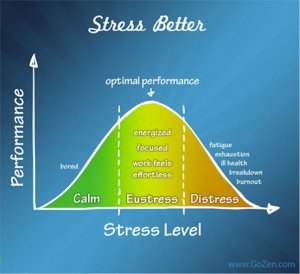Can Stress Help Students?
Stress might not always be the enemy. Research shows that positive stress can strengthen the immune system, enhance memory and learning, and improve decision-making skills.
Imagine this: You're a ninth-grade math teacher, and you've just been anointed as head of the school's wellness committee, a team thrown together to deal with student stress levels that are "far too high." "We need to build a more positive climate," your principal explained. "You're relatable. Students might listen to what you have to say." Now you're writing a speech for the year's first all-school assembly on a topic outside your expertise: stress management.
The speech you deliver is full of well-documented horror stories about the ill effects of stress. The following morning, the principal comes to you and explains that stress levels have skyrocketed! You’re baffled. You were just stating the facts. What did you do wrong? Nothing. Well, nothing obvious, at least. You just approached the issue in much the same way that the multi-billion-dollar stress management industry does. You told the story of stress as shaped by science, news, and popular culture. Here’s the narrative in a nutshell: Stress is bad, very bad.
In fact, another body of research reveals that stress can actually enhance performance and well-being. Yes, there is something known as "good" stress. And research shows that making people aware of good stress is a more powerful antidote to its ills than jarring them with statistics.
I propose that we shift our goal from asking students to stress less toward helping them stress better. Here are seven ideas to do just that.
1. Stop Highlighting Negative Consequences
It's our natural instinct to make children aware that they are potentially hurting themselves. But focusing solely on the harm caused by stress indicates to students that stress is bad in an absolute sense, which is simply untrue. Additionally, combating stress using fear tactics can create even more stress. Thoughts like "Oh no, I'm stressed, and stress is bad" will only exacerbate the child's worries. The research confirms that stress itself is stressful.
Recent studies by Yale and Harvard researchers reveal that corporate trainers who focused on the negative ramifications of stress increased stress in trainees. While this research was conducted on a business population, let's extrapolate that the effect on students might be the same. To stress better, students should understand this reality: A certain amount of stress is OK. It can even be good for you.
2. Introduce the Evolutionary Purpose of Stress
Students of all ages love to know that stress is part of human design. Think about our ancestors who hunted and gathered food. When attacked by a saber-toothed cat, chemicals were pumped into the body to help fight the predator or flee. This evolutionary reaction to danger is known as the stress response -- it's a survival mechanism. In modern times, we don't typically need to flee from predators, but the stress response still has a purpose. A certain amount of stress can help us marshal the resources necessary to reach a goal. Studies even demonstrate that as stress increases, so too can performance.
3. Explore Distress and Eustress
There are two main types of stress: positive and negative, also known as distress and eustress. Most kids have experienced eustress. Ask them to think of a time when their heart was racing but there was no immediate threat or fear. Maybe they were riding a roller coaster, watching a scary movie, or going on a first date. That feeling is good stress! Eustress can help boost motivation, focus, and energy; create a feeling of excitement; and improve performance and decision making. It's generally short-term in nature. By contrast, distress (commonly referred to as "stress") can cause anxiety or concern, is often outside our coping capacities, can decrease performance and lead to mental and physical problems, and may be short- or long-term in nature. Graphing a continuum of the different types of stress can really bring the point home for students.

4. Study the Researched Benefits
Lend these ideas credibility by citing recent science examining the benefits of stress:
Stress can help the immune system.
In one study by the Stanford University School of Medicine, patients who demonstrated higher short-term stress before knee surgery recovered twice as fast as those who were not as stressed.
Stress can improve memory and learning.
According to Cornell University neuroscientist Connor Liston, short bursts of the stress hormone cortisol can increase the brain's openness to learning. In other studies, Michael Gass, Chair of the Kinesiology Department at the University of New Hampshire, has found that those who take physical risks like bungee jumping can process information far faster than control groups.
Stress can improve decision making.
A study by Charles Morgan of Yale Medical School showed soldiers in a mock prisoner-of-war camp secreting a particular amino acid contributing to much higher cognitive functioning and better decision making. Morgan has conducted several like studies with similar results.
5. Cultivate a Positive Stress Mindset
One of the simplest yet most powerful ways to stress better is to start with the right mindset. Harvard and Yale researchers recently conducted an experiment on two groups of stressed-out investment bankers. The first group viewed a video about how stress is debilitating. The second group viewed a video about how stress enhances the body and brain. What happened? The second group -- primed with the mindset that stress was good for them -- felt more productive and energetic. This group also reported less fatigue and fewer headaches and backaches associated with distress. The results of this study are significant: Thinking about stress as "good" or performance-enhancing can work to your advantage.
For kids, this research can be applied immediately. For example, during test time, a pounding heart can be reframed by saying, "Hey, a little stress is actually helping me on this test -- my body's giving me a little burst of energy and extra focus to get through this."
6. Encourage Contingency Planning
The goal of stressing better is not for students to live in a fantasyland where they never encounter issues that cause real distress. Challenges will arise, and distress may follow, but instead of falling into a downward spiral of negativity, stressing better means creating contingency plans. When the body goes into flight-or-fight mode during distress, it can be hard to think clearly. A back-up plan can get students through it. So how is this done? Let's borrow a technique from goal-setting researchers.
Studies on goal setting show that you're more likely to stay on task by using a technique called MCII (mental contrasting and implementation intentions). With this method, you first visualize your end goal (e.g., getting a B or higher on the next science test), and then envision obstacles that might prevent you from getting there (e.g., missing study group, feeling nervous). Next, using if . . . then statements, create a plan to overcome the obstacles before they even happen:
7. Exemplify Distress Leading to Growth
Sally Walker was a survivor of an airline crash that killed 83 people. She said:
In his memoir No Such Thing as a Bad Day, Hamilton Jordan noted:
What Sally and Hamilton were referring to is the idea that what doesn't kill you can literally make you stronger -- and the studies support this. Students may be familiar with the term post-traumatic stress, but recent research from the University of North Carolina details a phenomenon called post-traumatic growth. PTG is the positive change resulting from a major life crisis (or serious distress). Researchers studied survivors of severe accidents, people who have gone through divorce, and even former prisoners of war. In all of these situations, some come out stronger than before. PTG results in their feeling more connected with their friends and family, more resilient, and more grateful. Researchers found that those who tend to experience PTG usually approach difficulty rather than avoiding it -- they are more open to change.
In our effort to stress better, let's teach students that when stress comes on, they should embrace it rather than run away from it. When in a situation of distress, kids can think of the examples above or a personal example where distress has led to positive change. These are reminders that something good -- even great -- can come from our challenges.
